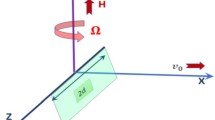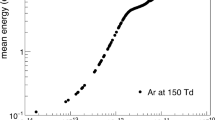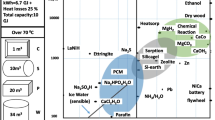Abstract
The directionality of thermal radiance of a homogeneous isothermal non-black plane surface is totally decided by its directional emissivity, which depends on the complex dielectric constant and roughness of surface. It can be expressed by \(\bar L_\lambda (\theta _k ,T) = \bar \varepsilon _\lambda (\theta _\lambda )L_{b\lambda } (T)\). This paper proves that it is necessary to express emissivity by a matrix when a target becomes an inhomogeneous non-isothermal open complex with complicated inner geometric structure. The matrix describes the inner radiative interaction among components accurately and also expresses its thermal radiative directionality and structural characteristics completely. Advantages of matrix expression are as follows: first, the physical mechanics of effective emissivity of an open complex is described in a simple and perfect way; second, it becomes easy to understand the principle and method to retrieve components temperature from multi-angle thermal remotely sensed data; and third, the differences of directionalities between an open complex and a homogeneous isothermal non-black plane body are expressed by just using an effective emissivity matrix instead of an emissivity vector. Formula \(\bar L_\lambda (\theta _k ,T) = \varepsilon _\lambda (\theta _\lambda )L_{b\lambda } (T)\) in classic physics is only the special case of matrix expression; therefore, the matrix is a universal unconditional expression to describe the directionality of thermal radiance.
Similar content being viewed by others
References
Norman, J., Becker, F., Terminology in thermal infrared remote sensing of natural surface, Agriculture and Forest Meterology, 1995, 77: 153–176.
Wan, Z., Dozier, J., Ageneralized split-window algorithm for retrieving land-surface temperature from space, IEEE Trans, on Geosci. and Remote Sens., 1996, 34(4): 892–905.
Becker, F., Li Zhaoliang, Surface temperature and emissivity at various scales: Difinition, measurement, and related problem, Remote Sensing Review, 1995, 12: 225–253.
Li Xiaowen, Wang Jindi, Strahler, A. H., Scale effects and scaling-up by geometric-optical model, Science in China, Ser. E, 2000, 43(Supplement): 17–22.
Li Xiaowen, Wang Jindi, Strahler, A. H., Scale effects of Planck’s law over nonisothermal blackbody surface, Science in China, Ser. E, 1999, 42(6): 652–656.
Li Xiaowen, Wang Jindi, Hu Baoxin et al., On utilization of a priori knowledge in inversion of remote sensing models, Science in China, Ser. D, 1998, 41(6): 580–588.
Xu Xiru, Chen Liangfu, Zhuang Jiali, Genetic inverse algorithm for retrieval of component temperature of mixed pixel by multi-anglar thermal infrared remote sensing data, Science in China, Ser. D, 2001, 44(4): 363–372.
Li Xiaowen, Strahler, A. H., Friedl, M. A., A conceptual model for effective directional emissivity from non-isothermal surface, IEEE Trans, on Geoscience and Remote Sensing, 1999, 37(5): 1–10.
Chen Liangfu, Zhuang Jiali, Xu Xiru, The concept of effective emissivity of non-isothermal mixed pixel and its test, Chinese Science Bulletin, 2000, 45(9): 788–795.
Author information
Authors and Affiliations
Corresponding author
Rights and permissions
About this article
Cite this article
Xu, X., Fan, W. & Chen, L. Matrix expression of thermal radiative characteristics for an open complex. Sci. China Ser. D-Earth Sci. 45, 654–661 (2002). https://doi.org/10.1360/02yd9066
Received:
Issue Date:
DOI: https://doi.org/10.1360/02yd9066




